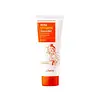What's inside
What's inside
 Key Ingredients
Key Ingredients

 Benefits
Benefits

 Concerns
Concerns

 Ingredients Side-by-side
Ingredients Side-by-side

Water
Skin ConditioningChamaecyparis Obtusa Water
MaskingGlycerin
HumectantSodium Cocoyl Isethionate
CleansingSodium Methyl Cocoyl Taurate
CleansingHydroxypropyl Starch Phosphate
Cocamidopropyl Betaine
CleansingPropylene Glycol Distearate
Emollient1,2-Hexanediol
Skin ConditioningDisodium Cocoyl Glutamate
CleansingPotassium Cocoyl Glycinate
Tea-Cocoyl Glutamate
CleansingButylene Glycol
HumectantPanthenol
Skin ConditioningSaccharomyces/Rice Ferment Filtrate
Skin ConditioningHouttuynia Cordata Extract
Skin ConditioningArtemisia Princeps Extract
Skin ConditioningCetearyl Alcohol
EmollientGlyceryl Stearate
EmollientPotassium Cocoate
EmulsifyingCitric Acid
BufferingSodium Chloride
MaskingHydroxyacetophenone
AntioxidantEthylhexylglycerin
Skin ConditioningWater, Chamaecyparis Obtusa Water, Glycerin, Sodium Cocoyl Isethionate, Sodium Methyl Cocoyl Taurate, Hydroxypropyl Starch Phosphate, Cocamidopropyl Betaine, Propylene Glycol Distearate, 1,2-Hexanediol, Disodium Cocoyl Glutamate, Potassium Cocoyl Glycinate, Tea-Cocoyl Glutamate, Butylene Glycol, Panthenol, Saccharomyces/Rice Ferment Filtrate, Houttuynia Cordata Extract, Artemisia Princeps Extract, Cetearyl Alcohol, Glyceryl Stearate, Potassium Cocoate, Citric Acid, Sodium Chloride, Hydroxyacetophenone, Ethylhexylglycerin
Water
Skin ConditioningCocamidopropyl Betaine
CleansingGlycerin
HumectantAcrylates Copolymer
1,2-Hexanediol
Skin ConditioningSodium Chloride
MaskingCoptis Japonica Root Extract
Skin ConditioningHippophae Rhamnoides Extract
MaskingSalicylic Acid
MaskingAscorbic Acid
AntioxidantAcrylates/C10-30 Alkyl Acrylate Crosspolymer
Emulsion StabilisingTromethamine
BufferingChlorhexidine Digluconate
AntimicrobialCitrus Paradisi Peel Oil
MaskingLimonene
PerfumingWater, Cocamidopropyl Betaine, Glycerin, Acrylates Copolymer, 1,2-Hexanediol, Sodium Chloride, Coptis Japonica Root Extract, Hippophae Rhamnoides Extract, Salicylic Acid, Ascorbic Acid, Acrylates/C10-30 Alkyl Acrylate Crosspolymer, Tromethamine, Chlorhexidine Digluconate, Citrus Paradisi Peel Oil, Limonene
Ingredients Explained
These ingredients are found in both products.
Ingredients higher up in an ingredient list are typically present in a larger amount.
1,2-Hexanediol is a synthetic liquid and another multi-functional powerhouse.
It is a:
- Humectant, drawing moisture into the skin
- Emollient, helping to soften skin
- Solvent, dispersing and stabilizing formulas
- Preservative booster, enhancing the antimicrobial activity of other preservatives
Cocamidopropyl Betaine is a fatty acid created by mixing similar compounds in coconut oil and dimethylaminopropylamine, a compound with two amino groups.
This ingredient is a surfactant and cleanser. It helps gather the dirt, pollutants, and other impurities in your skin to be washed away. It also helps thicken a product and make the texture more creamy.
Being created from coconut oil means Cocamidopropyl Betaine is hydrating for the skin.
While Cocamidopropyl Betaine was believed to be an allergen, a study from 2012 disproved this. It found two compounds in unpure Cocamidopropyl Betaine to be the irritants: aminoamide and 3-dimethylaminopropylamine. High-grade and pure Cocamidopropyl Betaine did not induce allergic reactions during this study.
Learn more about Cocamidopropyl BetaineGlycerin is already naturally found in your skin. It helps moisturize and protect your skin.
A study from 2016 found glycerin to be more effective as a humectant than AHAs and hyaluronic acid.
As a humectant, it helps the skin stay hydrated by pulling moisture to your skin. The low molecular weight of glycerin allows it to pull moisture into the deeper layers of your skin.
Hydrated skin improves your skin barrier; Your skin barrier helps protect against irritants and bacteria.
Glycerin has also been found to have antimicrobial and antiviral properties. Due to these properties, glycerin is often used in wound and burn treatments.
In cosmetics, glycerin is usually derived from plants such as soybean or palm. However, it can also be sourced from animals, such as tallow or animal fat.
This ingredient is organic, colorless, odorless, and non-toxic.
Glycerin is the name for this ingredient in American English. British English uses Glycerol/Glycerine.
Learn more about GlycerinChances are, you eat sodium chloride every day. Sodium Chloride is also known as table salt.
This ingredient has many purposes in skincare: thickener, emulsifier, and exfoliator.
You'll most likely find this ingredient in cleansers where it is used to create a gel-like texture. As an emulsifier, it also prevents ingredients from separating.
There is much debate on whether this ingredient is comedogenic. The short answer - comedogenic ratings don't tell the whole story. Learn more about comegodenic ratings here.
The concensus about this ingredient causing acne seems to be divided. Research is needed to understand if this ingredient does cause acne.
Scrubs may use salt as the primary exfoliating ingredient.
Learn more about Sodium ChlorideWater. It's the most common cosmetic ingredient of all. You'll usually see it at the top of ingredient lists, meaning that it makes up the largest part of the product.
So why is it so popular? Water most often acts as a solvent - this means that it helps dissolve other ingredients into the formulation.
You'll also recognize water as that liquid we all need to stay alive. If you see this, drink a glass of water. Stay hydrated!
Learn more about Water